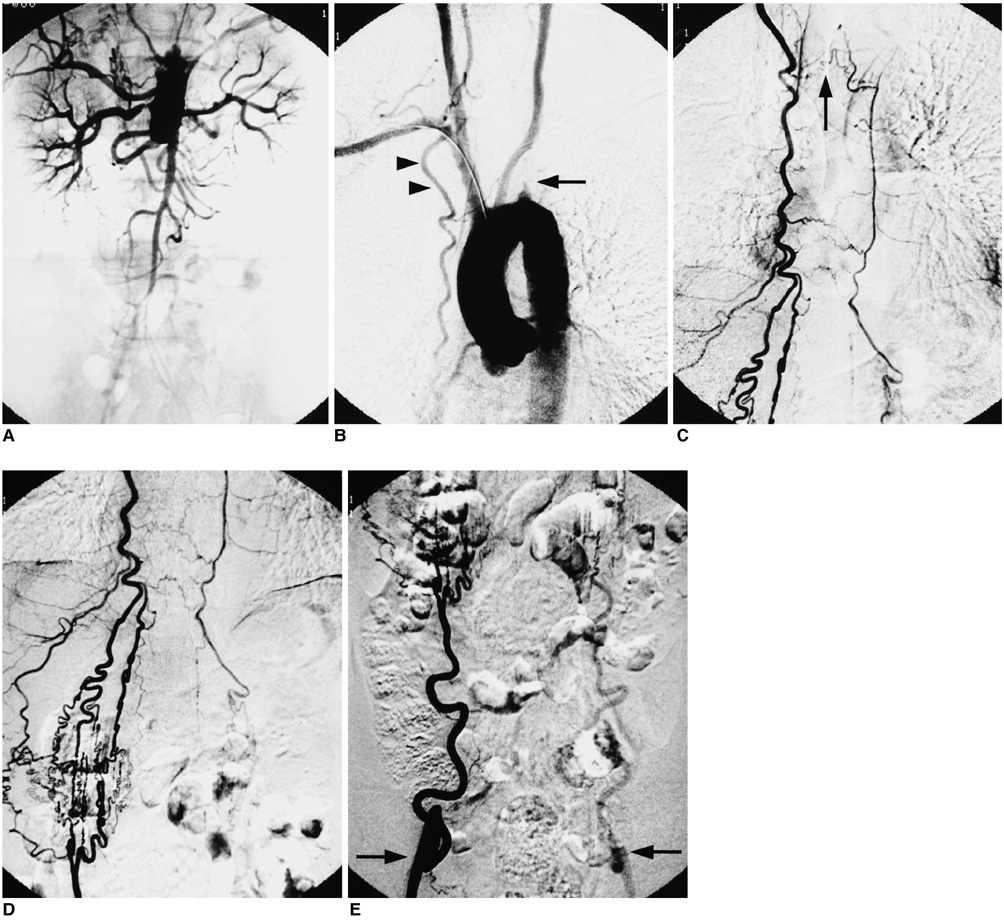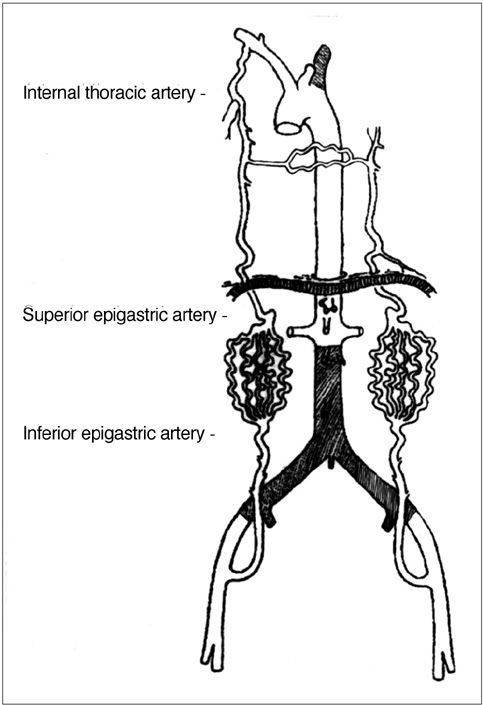Korean J Radiol.
2003 Sep;4(3):179-183. 10.3348/kjr.2003.4.3.179.
Internal Thoracic Artery Collateral to the External Iliac Artery in Chronic Aortoiliac Occlusive Disease
- Affiliations
-
- 1Department of Diagnostic Radiology and Research Institute of Radiological Science, Yonsei University College of Medicine. dyl@yumc.yonsei.ac.kr
- KMID: 754022
- DOI: http://doi.org/10.3348/kjr.2003.4.3.179
Abstract
OBJECTIVE
To evaluate the incidence and angiographic findings of the collateral pathway involving the internal thoracic artery in patients with chronic aortoiliac occlusive disease. MATERIALS AND METHODS: Between March 2000 and Februrary 2001, 124 patients at our hospital underwent angiographic evaluation of chronic aortoiliac occlusive disease, and in 15 of these complete obstruction or severe stenosis of the aortoiliac artery was identified. The aortograms and collateral arteriograms obtained, including internal thoracic arteriograms, as well as the medical records of the patients involved, were evaluated. RESULTS: In nine patients there was complete occlusion of the infrarenal aorta, or diffuse stenosis of 75% or more in the descending thoracic aorta, and in the other six, a patent aorta but complete occlusion or stenosis of 75% or more of the common iliac artery was demonstrated. Collateral perfusion via hypertrophied internal thoracic arteries and rich anastomoses between the superior and inferior epigastric arteries, reconstituting the external iliac artery, were noted in all fifteen patients, regardless of symptom duration, which ranged from six months to twelve years. CONCLUSION: In patients with chronic aortoiliac occlusive disease, the internal thoracic artery, along with visceral collaterals and those from the contralateral side, is one of the major parietal collateral pathways.
Figure
Reference
-
1. Chait A. The internal mammary artery: an overlooked collateral pathway to the leg. Radiology. 1976. 121:621–624.2. Krupski WC, Sumchai A, Effeney DJ, Ehrenfeld WK. The importance of abdominal wall collateral blood vessels. Arch Surg. 1984. 119:854–859.3. Vine HS, Sacks BA. Visualization of the distal arterial vessels in complete aortic occlusion. AJR Am J Roentgenol. 1980. 134:847–848.4. Grollman JH Jr. Winslow's pathway-it's not the only way. Catheter Cardiovasc Interv. 2000. 49:445–446.5. Edwards EA, Lemay M. Occlusion patterns and collaterals in arteriosclerosis of the lower aorta and iliac arteries. Surgery. 1955. 38:950–963.6. Tsui SSL, Parry AJ, Large SR. Leg ischemia following bilateral internal thoracic artery and inferior epigastric artery harvesting. Eur J Cardiothorac Surg. 1995. 9:218–220.7. Dietzek A, Goldsmith J, Veith F, Sanchez L, Gupta S, Wengerter K. Interruption of critical aortoiliac collateral circulation during nonvascular operations: a cause of acute limb-threatening ischemia. J Vasc Surg. 1990. 12:645–653.8. Parashara DK, Kotler MN, Ledley GS, Yazdanfer S. Internal mammary artery collateral to the external iliac artery: an angiographic consideration prior to coronary bypass surgery. Catheter Cardiovasc Diagn. 1994. 32:343–345.9. Arnold JR, Greenberg J, Reddy K, Clements S. Internal mammary artery perfusing Leriche's syndrome in association with significant coronary arteriosclerosis: four case reports and review of literature. Catheter Cardiovasc Interv. 2000. 49:441–444.10. Arnold JR, Greenberg JD, Clements S. Internal mammary artery perfusing the Leriche's syndrome. Ann Thorac Surg. 2000. 69:1244–1246.11. Arnold JR. Leriche's syndrome with total perfusion of the left lower extremity by way of the left internal mammary artery. Am J Cardiol. 1998. 82:997–999.12. Kitamura S, Inoue K, Kawachi K, et al. Lower extremity ischemia secondary to internal thoracic-coronary artery bypass grafting. Ann Thorac Surg. 1993. 56:157–159.13. Melissano G, Di Credico G, Chiesa R, Grossi A. The use of internal thoracic arteries for myocardial revascularization may produce acute leg ischemia in patients with concomitant Leriche's syndrome. J Vasc Surg. 1996. 24:698.14. Adar R, Rubinstein Z, Hirshberg A. Internal mammary artery coronary bypass and leg ischemia. J Vasc Surg. 1998. 7:820–821.15. Muller RF, Figley MM. The arteries of the abdomen, pelvis and thigh: I. Normal roentgenographic anatomy; II. Collateral circulation in obstructive arterial disease. Am J Roentgenol Radium Ther Nucl Med. 1957. 77:296–311.16. Prager RJ, Akin JR, Akin GC, Binder RJ. Winslow's pathway: a rare collateral channel in infrarenal aortic occlusion. AJR Am J Roentgenol. 1977. 128:485–487.17. Kwann JHM, Connolly JE. Doppler assessment of the inferior epigastric artery flow patterns as a screening test for aortoiliac obstruction. Am J Surg. 1979. 137:250–251.18. Bron KM. Thrombotic occlusion of the abdominal aorta. AJR Am J Roentgenol. 1966. 96:887–895.19. Isner JM, Rosenfeld K. Redefining the treatment of peripheral artery disease: Role of percutaneous revascularization. Circulation. 1993. 88:1534–1557.
- Full Text Links
- Actions
-
Cited
- CITED
-
- Close
- Share
- Similar articles
-
- A Case of Complex Restenosis of Aortoiliac Stent Mimicking Downward Stent Migration
- The accidental renal artery embolism in patient with aortoiliac occlusive disease with unilateral renal atrophy during aortobifemoral bypass graft: A case report
- Single Tract Aortic Revascularization Technique in the Treatment of Aortoiliac Occlusive Disease
- Endovascular Management for Chronic Steno-occlusion of Iliac and Femoral Arteries
- Hybrid Coronary Artery Revascularization for Takayasu Arteritis with Major Visceral Collateral Circulation from the Left Internal Thoracic Artery



